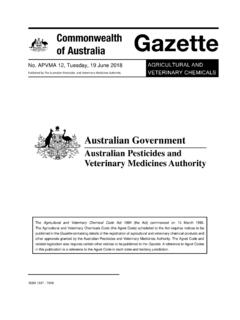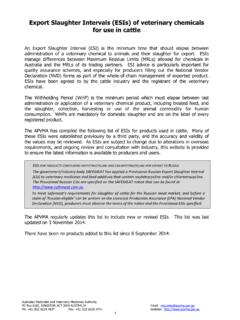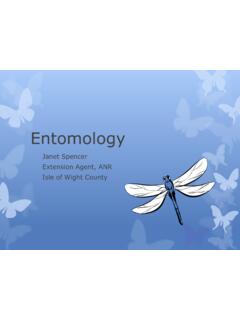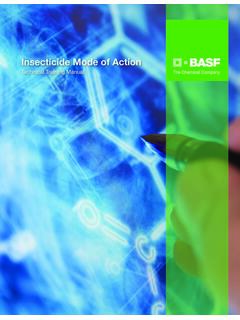Transcription of Safety of Fipronil in Dogs and Cats: a review of literature
1 Safety of Fipronil in Dogs and Cats : a review of literature Conducted on behalf of the Australian Pesticides and Veterinary Medicines Authority (APVMA) Fipronil Animal Safety review Page 2 of 21 Table of Contents 1 Introduction .. 3 2 Methodology of assessment .. 3 3 Mechanism of action .. 4 4 Metabolism of Fipronil .. 4 5 Published studies investigating the efficacy of Fipronil -containing products .. 5 6 Adverse drug experience reports for Fipronil in dogs and cats .. 6 ADEs in Australia.
2 6 Off label use of Fipronil .. 7 Efficacy issues .. 8 ADEs in USA .. 8 Global ADE reports .. 9 7 Summary and interpretations .. 9 Oral toxicity .. 9 Neurotoxicity .. 10 Endocrine disruption .. 11 Skin Absorption .. 12 Transdermal penetration of Fipronil and/or metabolites .. 13 Toxicity in cats .. 13 Toxicity in young animals .. 13 Toxicity of metabolites .. 14 Adverse Drug Experiences .. 14 8 Conclusions .. 15 9 References .. 17 Fipronil Animal Safety review Page 3 of 21 1 Introduction Fipronil [5-amino-3-cyano-1-(2,6-dichloro -4-trifluoromethylphenyl)-4-fluoromethyl sulfinyl pyrazole] is a second-generation phenylpyrazole insecticide used extensively as a agricultural and veterinary pesticide (US Environmental Protection Agency, 1996; Hovda and Hooser, 2002; Tingle et al.)
3 , 2003). In Australia, Fipronil was first registered as a veterinary pesticide in 1995 as Frontline Spray, with the spot-on form of Fipronil (Top Spot) registered from 1996 onwards for dogs, cats, puppies and kittens (Australian Pesticides and Veterinary Medicines Authority (APVMA) website). At the commencement of the review there were four active constituent approvals and 29 registered products containing the active constituent Fipronil for agricultural and veterinary use (Australian Pesticides and Veterinary Medicines Authority, 2003).
4 Fipronil was first registered for animal health in the USA in 1996, consisting of Frontline Spray, containing w/w Fipronil (Technical Information Sheet, 1997b), and Frontline Top Spot, containing Fipronil w/w (Technical Information Sheet, 1997a). The concentration of the active constituent in Fipronil products registered in Australia varies marginally from the USA, with Frontline spray containing g/L ( ) Fipronil and the topical concentrate containing 100 g/L (10%) Fipronil , according to the approved label for these products (APVMA website).
5 An insect growth regulator, (S)-methoprene [90 g/L (9%) for dogs or 120 g/L (12%) for cats], has also been included with several of the products containing Fipronil ( Frontline Plus for dogs or cats and Startgard Plus for puppies or kittens). Fipronil -containing products have proven an effective therapy to control fleas (Hutchinson et al., 1998; Ritzhaupt et al., 2000b, a; Cadiergues et al., 2001; Jacobs et al., 2001; Mehlhorn et al., 2001; Moyses and Gfeller, 2001; Medleau et al., 2002; Medleau et al., 2003), ticks (Estrada-Pena and Ascher, 1999; Young et al.)
6 , 2003), biting lice (Pollmeier et al., 2002; Pollmeier et al., 2004), trombiculid mites (Nuttall et al., 1998) and other mites (Curtis, 1996; Bordeau and Hubert, 2000; Curtis, 2004) in dogs and cats. Veterinary pesticides containing Fipronil have the following label claims: Spray: up to 12 wks for fleas on dogs and 8 wks for fleas on cats; Flea Allergy Dermatitis (FAD) apply monthly; paralysis ticks apply every 3 wks, brown dog tick up to 4 wks. Dog spot ons: monthly for fleas, FAD and brown dog tick; 2 wks for paralysis tick.
7 Cat spot-ons: monthly for fleas and FAD; note NO claim for paralysis tick.) There have been a number of reports of Adverse Drug Experiences (ADEs) following the use of Fipronil -containing products. These ADEs have been reported in target and non-target animal species and in humans either applying the product or handling the target animal after application. The purpose of this review is to summarize the published and unpublished information concerning the Safety of Fipronil in the target species (dogs and cats), as well as off-label use in non-target species, and to present an objective assessment of the potential risks.
8 2 Methodology of assessment The information used to form this review was obtained from published and unpublished sources of information, including international databases, scientific publications, web-based peer review ( Veterinary Information Network (VIN) website), the APVMA Adverse Experience Reporting Fipronil Animal Safety review Page 4 of 21 Program (AERP) and, also, information provided by the applicant regarding global suspected ADE reports. Two reviews that were particularly helpful in summarizing the available information on toxicological studies concerning Fipronil and/or its metabolites were: (i) Pesticide Residues in Food 1997 , resulting from a joint meeting of FAO experts on pesticide residues in food and the environment and the WHO Core assessment group, with the support of the International Programme on Chemical Safety (IPCS).
9 (ii) Pesticide Residues in Food 2000: Fipronil , prepared by Virginia Dobozy for the Environmental Protection Agency (EPA), Washington DC, USA. These studies included in vivo acute and chronic toxicology studies conducted in laboratory animals (rats, mice, rabbits, dogs) and in vitro studies. Many of the toxicological studies, particularly chronic dosing studies, were performed in laboratory animals. It could be expected that there may be some overlap between information obtained from the search of published and unpublished literature .
10 A majority of the toxicological studies originated from unpublished reports supplied by Rhone-Poulenc Inc. to international regulatory agencies, including the World Health Organisation (WHO) and the US Environmental Protection Agency (EPA). 3 Mechanism of action Fipronil exhibits high insecticidal activity against many insects and other arthropod pests (Tingle et al., 2003). The principle mechanism of action is against the -aminobutyric acid (GABA) receptor-chloride complex. Ligand-gated chloride channels, such as GABA, act to inhibit excitable membranes.












